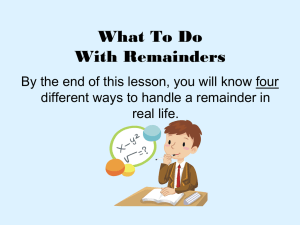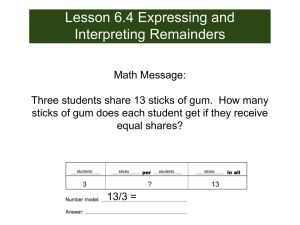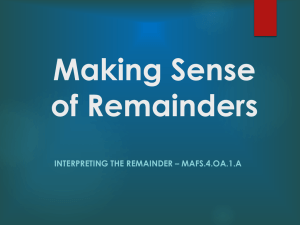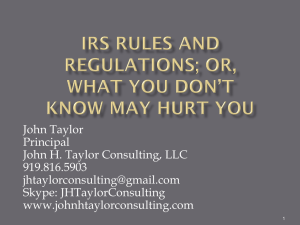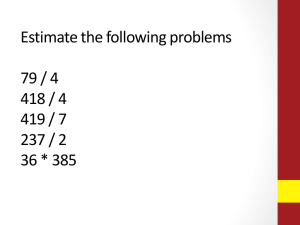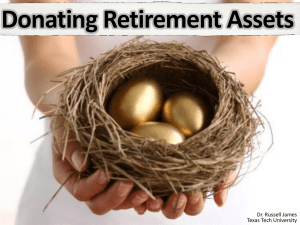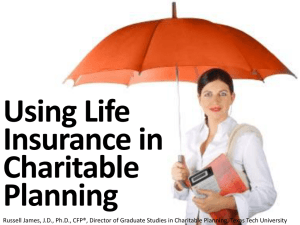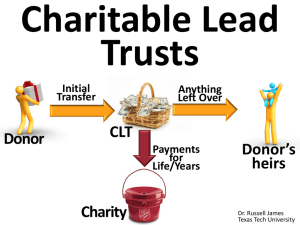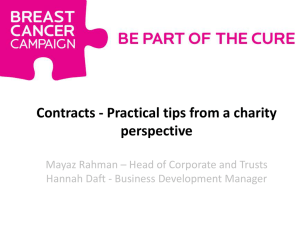pptx (high res) - EncourageGenerosity.com
advertisement
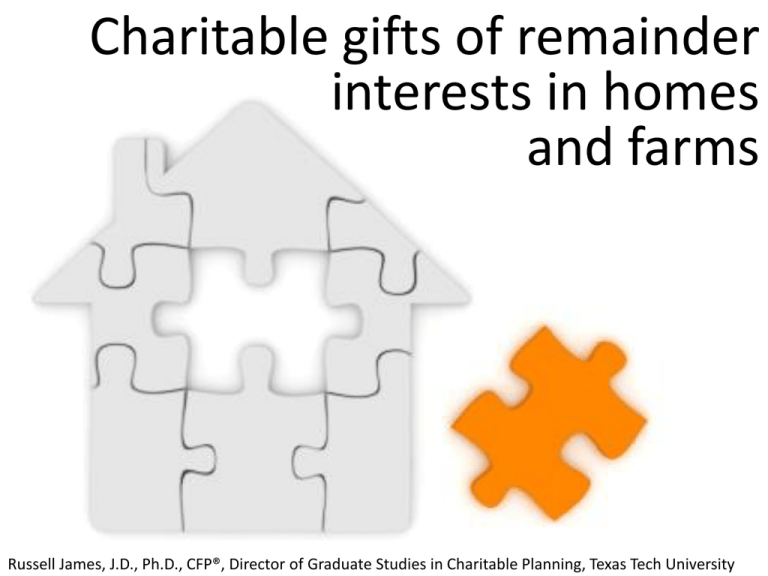
Charitable gifts of remainder interests in homes and farms Russell James, J.D., Ph.D., CFP®, Director of Graduate Studies in Charitable Planning, Texas Tech University General rule: you can’t deduct a partial interest gift A partial interest gift occurs when a donor gives some rights to property but keeps others General rule: you can’t deduct a partial interest gift But, you can deduct a remainder interest in a home or farm Other Exceptions • Giving all or an “undivided portion” of a property interest • Charitable remainder/ lead trust or pooled income fund • Qualified conservation easement A remainder interest gives the right to own the property after a set time or after the death of a person Unlike a will, a remainder interest is not revocable, and can even be sold A deductible remainder interest in farmland or a home must be transferred by deed, not by trust or contract A farm is any land and improvements used (even by a tenant) to raise crops or livestock A remainder interest in any part of a farm may be gifted (Rev. Rul. 78-303) 12.5% 25% Can I give a remainder interest of an undivided share in farmland? 12.5% 25% Yes, donor may deduct a remainder interest shared by charity and others as tenants in common (Rev. Rule 87-37) 12.5% 25% However, IRS may deduct cost of partitioning (of forcing a sale or division) mineral rights • No deduction for remainder just in mineral rights because it is not a “farm” • Can gift remainder in entire “fee simple” farm (even if land and mineral rights go to separate charities) • Can gift remainder in farm without mineral rights if you don’t owned them Reg. 1.170A-7(b)(4) PLR 8316037 How do you calculate the deduction for a remainder interest in farmland? 1. Find the §7520 interest rate (http://www.irs.gov/businesses/small/article/0,,id=112482,00.html) 2. Multiply value of land by remainder percentage in IRS Pub. 1457 (one or two lives or specific term) (http://www.irs.gov/retirement/article/0,,id=206601,00.html) Ex: A remainder interest in $100,000 of farmland given by a 59 year old donor on 9/6/10 1. Find the §7520 interest rate 2.4% (http://www.irs.gov/businesses/small/article/0,,id=112482,00.html) 2. Use remainder value in IRS Pub. 1457 for one or two lives or specific term (http://www.irs.gov/retirement/article/0,,id=206601,00.html) 3. Multiply remainder value by value of the farmland Ex: A remainder interest in $100,000 of farmland given by a 59 year old donor on 9/6/10 1. Find the §7520 interest rate 2.4% (http://www.irs.gov/businesses/small/article/0,,id=112482,00.html) 2. Multiply value of land by remainder percentage in IRS Pub. 1457 (one or two lives or specific term) (http://www.irs.gov/retirement/article/0,,id=206601,00.html) Section 1 $100,000 X 0.60589 = $60,589 Table S - Based on Life Table 2000CM Interest at 2.4 Percent Age 0 1 2 3 4 Annuity 34.2376 34.3011 34.1418 33.9727 33.7967 Life Estate 0.82170 0.82323 0.81940 0.81534 0.81112 Remainder 0.17830 0.17677 0.18060 0.18466 0.18888 Age 55 56 57 58 59 Annuity 18.1993 17.7570 17.3129 16.8678 16.4213 Life Estate 0.43678 0.42617 0.41551 0.40483 0.39411 Remainder 0.56322 0.57383 0.58449 0.59517 0.60589 Charitable Deduction Deduction for remainder interest in $100,000 farm by age 59 donor 11.6% (May 89) 2.0% (Oct 10) $15,684 $65,553 Leaving land to charity Leaving land to charity by will by remainder interest • Revocable • $0 income tax deduction • Impacts charity after death • Irrevocable • $60,589 immediate income tax deduction • Impacts charity after death or immediately if charity sells remainder interest Because farmland can be gifted in parts, a donor could annually give remainder interests up to income limits or desired marginal tax rate • Allows for increasing valuation each year • Avoids risk of losing carryover deduction at death • Could use value of annual deductions to pay for ILIT life insurance passing tax free to heirs Donor can use money from remainder tax deduction to buy tax free life insurance (ILIT) for children’s inheritance Age 59 wealthy donor with $100,000 farmland on 9/1/10 remainder interest in farmland given to charity will divides farmland 10% to charity 90% to children $60,589 tax deduction x 41% combined tax rate = $24,841 $24,841 buys est. $70,000 paid up ILIT life insurance farmland worth $125,000 at death charity receives $125,000 farmland children receive $70,000 (tax free from ILIT) children receive $50,625 (90% x 125,000 = 112,500, less 55% for estate taxes) charity receives $12,500 (10% x $125,000) Gifts of remainder interests in personal residences can also be deducted Includes second homes, vacation homes, even a boat with bathroom, cooking, and sleeping facilities, if used by the donor as a residence Deduction for a house is reduced because, unlike land, it is depreciable (it wears out) Rules in IRS Pub. 1459 http://www.irs.gov/pub/irs-pdf/p1459.pdf 59 year old donor giving on 9/6/10 Remainder interest in $100,000 farm .60589 x $100,000 $60,589 Deduction Remainder interest in $100,000 home .60589 x $20,000 (land) .60589 x $10,000 (salvage) .33768 x $70,000 * $41,814 Deduction *.60589 less .26821 depreciation reduction calculated on next slide Depreciation reduction factor R factor age now – R factor age after useful life of house D factor age now X Useful life of house Appraiser can estimate. IRS examples use 45 years. Table C(2.4) Factors for Reducing Assurances - Based on Table 2000CM Interest at 2.4 Percent Age Remainder R-Factors x 0 1 2 3 4 … … 48 49 Factors .17830 .17677 .18060 .18466 .18888 …… .49158 .50143 Rx-0.5Mx D-Factors Dx Age Remainder x 1202916 100000.0 55 1185429 96977.54 56 1168311 94656.94 57 1151231 92407.69 58 1134179 90219.15 59 … … … … … … 418809.2 30218.64 103 404011.4 29397.77 104 Factors .56322 .57383 .58449 .59517 .60589 …… .95802 .96077 R-Factors D-Factors Rx-0.5Mx Dx 317860.0 304002.2 290311.8 276800.1 263478.6 … 60.91156 33.72948 Table C at http://www.irs.gov/retirement/article/0,,id=206601,00.html 24748.54 24008.45 23274.97 22547.02 21825.10 … … 35.63595 21.05020 263478.6-60.91156 21825.1-45 =.26821 What if the donor leaves? What if the donor leaves? Give life estate to charity Agree with Give life the charity to estate to a joint sale charity in and divide exchange for proceeds a gift annuity Rent property Sell life estate Will the donor maintain the property? Will the donor maintain the property? What if I make improvements to the property after giving a remainder interest? You can deduct the remainder value of major improvements as additional gifts PLR 9329017; PLR 8529014 Charitable gifts of remainder interests in homes and farms Photos from www.istockphoto.com Help me convince my bosses that continuing to build and post these slide sets is not a waste of time. If you work for a nonprofit or advise donors and you reviewed these slides, please let me know by clicking HERE If you clicked on the link to let me know you reviewed these slides… Thank You! For the audio lecture accompanying this slide set, go to EncourageGenerosity.com Think you understand it? Prove it! Click here to go to EncourageGenerosity.com and take the free quiz on this slide set. (Instantly graded with in depth explanations and a certificate of completion score report.) Graduate Studies in Charitable Financial Planning at Texas Tech University This slide set is from the introductory curriculum for the Graduate Certificate in Charitable Financial Planning at Texas Tech University, home to the nation’s largest graduate program in personal financial planning. To find out more about the online Graduate Certificate in Charitable Financial Planning go to www.EncourageGenerosity.com To find out more about the M.S. or Ph.D. in personal financial planning at Texas Tech University, go to www.depts.ttu.edu/pfp/ About the Author Me (about 5 years ago) ® Russell James, J.D., Ph.D., CFP is an Associate Professor and the Director of Graduate Studies in Charitable Planning in the Division of Personal Financial Planning at Texas Tech University. He graduated, cum laude, from the University of Missouri School of Law where he was a member of the Missouri Law Review. While in law school he received the Lecturing in Germany. 75 extra students United Missouri Bank Award for Most Outstanding Work in Gift and Estate Taxation showed up. I thought it was for me until I and Planning and the American Jurisprudence found out there was free beer afterwards. Award for Most Outstanding Work in Federal Income Taxation. After graduation, he worked At Giving Korea 2010. I as the Director of Planned Giving for Central didn’t notice until later Christian College, Moberly, Missouri for six the projector was years and also built a successful law practice shining on my head (inter-cultural height limited to estate and gift planning. He later problems). served as president of the college for more than five years, where he had direct and supervisory responsibility for all fundraising. Dr. James received his Ph.D. in Consumer & Family Economics from the University of Missouri where his dissertation was on the topic of charitable giving. Dr. James has over 100 publications in print or in press in academic journals, conference proceedings, professional periodicals, and books. He writes regularly for Advancing Philanthropy, the magazine of the Association of Fundraising Professionals. He has presented his research in the U.S. and across the world including as an invited speaker in Ireland, Scotland, England, The Netherlands, Spain, Germany, and South Korea. (click here for complete CV)
